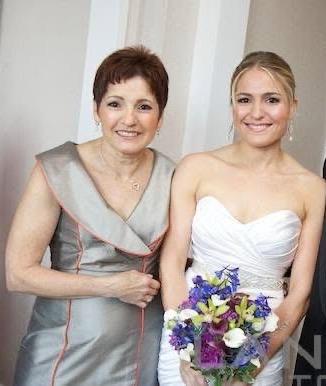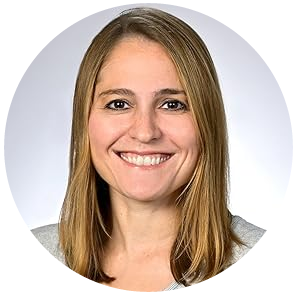
Q: You write a lot about grief and healing. How has your own experience with loss shaped your work?
A: In September, 2023, just six months after diagnosis, my mom, Cindy, died of esophageal cancer. My mom was a powerhouse: a master organizer, a devoted wife, a supreme chef, the world’s best Grammy to my kids, a spectacular quilt artist. She possessed a multitude of talents, but in the thirty-eight years I was lucky enough to have her as mine, mostly, she was my rock. My tether in this wild, strange world.
Her death was earth-shattering. Before she died, I thought bad things happened to other people. Losing my mom, swiftly and immediately broke me of this notion.
Bad things happen to anyone.
To everyone.
To my mom.
To me.
Her death carved a ginormous hole in the fabric of my life—reshaping everything I thought I knew.
Now, twenty-some-odd months into my grief, I’m not as broken as I first was. But I’ve learned grief is not something you move past—it’s something you carry. Forever. There is no finish line. Time changes the pain, but does not erase it. It is a piece of me—as real as my blood, hair, eyes and heart.
My mom’s death remains a deep scar singed into my chest. With time, the raw tissue has become more fibrous. More resilient. Yet, I know the wound will remain as long as I do.
Ironically though, the scar has also become my most humanizing piece. It is what connects me to every single other human on planet Earth.
It says: a bad thing happened to me.
It asks: what bad thing happened to you?
I’ve learned that pain, though brutal, can be transformative. That through loss we can find connection. Commonality. Purpose. Meaning.
Grief showed me that I’m raw and messy and here for just a moment—but so are we all.
I hope readers walk away from my novel feeling less alone in their sorrow. More empowered to build a life that truly matters to them—even (or especially) when it’s built from the pieces of something that broke apart life as they knew it.
Q: Your mom was a modern quilt artist. How has her creativity influenced yours?
A: My mom had an amazing brilliance—she could create incredible beauty out of silk fabrics. In truth, I never fully appreciated her artistic talent until after she died. But, in a lot of ways, I think writing is like quilting: you gather stray pieces of life, memory, and emotion, to try to turn them into something whole.
Her final gift to me was the lesson that I was an artist, too. She had actually just finished reading an early draft of Things That Break Us when she got sick. Her death came at a time when I was just discovering my creative voice.
Before she died, she was my cheerleader. After she died, she became my why. My reason.
Her death showed me that art survives our physical form. It is a mark we leave on the world that stays. Forever.
Today, her art is splayed all over my house and provides me so much comfort.
The idea of art remaining felt really powerful. I promised myself I would publish the novel—to do the thing that scared me the most, to jump over my ledge—because life is finite.
But art endures.
Q: What’s the best writing advice you’ve ever received?
A: “Write the story you want to read.” It sounds simple, but it’s easy to forget when you’re worried about what every potential reader is going to think about your story.
Q: What does “living authentically” mean to you?
A: It means listening to your gut instead of other people’s expectations. It means making choices that align with who you truly are, even if it’s scary. It’s about living a life that feels right on the inside, not just one that looks good on the outside.
Q: What song would be the soundtrack of your life?
A: “That’s the Way It Is” by Celine Dion — because the best course of action I’ve found when it comes with coping with reality …is surrender. Accepting the way it is. Huge thanks to Pema Chodron and Eckhart Tolle for guiding me in this life-changing lesson. Plus, let’s be real, Celine Dion is also iconic.
Q: What’s a piece of advice you wish you’d given your younger self?
A: Stop worrying so much about what people think (read: my dad). Trust yourself more. You’re allowed to want things that scare you or aren’t “prestigious” or “traditional.” Stepping off your path is where the magic and growth happens.
Q: How do you process difficult emotions in your writing?
A: Writing is how I give shape to feelings that might otherwise swallow me. It’s my way of making sense of the messiness of being human.
Q: What’s one place you’d love to visit that you haven’t yet?
A: New Zealand — the landscapes look magical, and I’d love to hike there (and drink all the wine!).
Q: What’s a book that changed your life — and why?
A: Wild by Cheryl Strayed — it reminded me of the healing power of facing your deepest pain. That grief can open a portal into profound learning and growth.
Q: What’s one thing most people don’t know about you?
A: I am (still) terrified of sharing my writing with anyone. It took me years (read: four decades) to find the courage to put my first book out into the world.
Q: If you had to describe yourself in three words, what would they be?
A: Compassionate. Resilient. Deep-feeler.
Q: What’s one thing you’ve learned about yourself through writing?
A: That I’m braver than I thought. Writing forces me to be vulnerable and honest. Every time I hit “publish” or share a piece, it’s like baring a piece of my soul.
Q: How did Botswana become such a big part of Things That Break Us?
A: My connection to Botswana began through my dad, who’s an infectious disease physician. In 2001, he founded the Botswana-UPenn Partnership to help provide free HIV/AIDS care across the country. Because of his work, I was lucky enough to travel to Botswana four times. In my twenties, I worked in the local hospital, Princess Marina, as a nursing student. There, I witnessed life, death, and human resilience in a way I never had before. The people, the land, the culture—it all left a lasting imprint on me. Those experiences became the emotional and geographic backbone of the novel.
Q: Is any of Things That Break Us based on your real experiences?
A: While the characters and plot are fictional, the emotional core of the book is very real. Like Tessa, when I worked in the hospital, I saw patients die in heartbreaking circumstances. It was the first place I truly confronted mortality. The safari scenes, too, are drawn from my real awe and sense of clarity while being in the African bush. Writing this story allowed me to process those experiences—and return to what I learned from them.
Q: What do you hope readers take away from the story?
A: I hope they see the power of stepping outside of what’s comfortable or familiar. Sometimes, it takes being far from home to finally come home to yourself. Botswana taught me to slow down, pay attention, and get honest about what matters. I hope that message stirs something in readers too.

